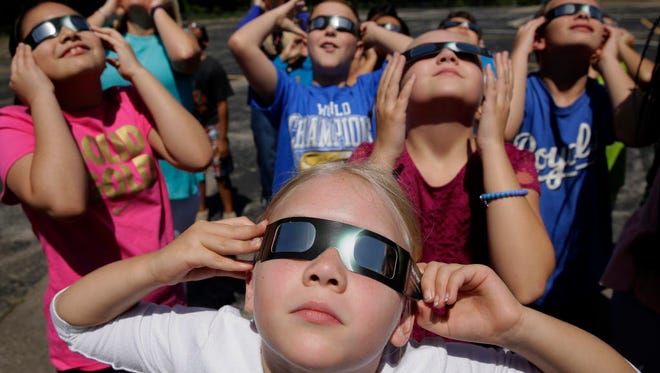Solar eclipse gives earthlings a chance to reflect on bigger picture
Consider Carl Sagan's words about 'the pale blue dot': Our view

Perhaps the only disappointing aspect of Monday’s coast-to-coast solar eclipse is that Carl Sagan isn’t around to provide color commentary. Sagan, the famed astronomer who died in 1996 at the age of 62, had an unparalleled ability to communicate the wonders of the universe and Earth’s place in it.
About that place: “We live on a hunk of rock and metal that circles a humdrum star that is one of 400 billion other stars that make up the Milky Way galaxy, which is one of billions of other galaxies. That is a perspective on human life and our culture that’s well worth pondering.”
When our moon passes directly between that humdrum star and our home planet, the juxtaposition will create an awe-inspiring spectacle for those in the path of totality stretching from Oregon to South Carolina. The Great American Eclipse represents an opportunity to step back from temporal concerns, such as the president’s latest tweet or the latest White House staff shuffle. It’s a chance to look up from our smartphones, peer at the sky and reflect on the bigger picture.
About that bigger picture: Back in 1990, when the Voyager spacecraft was preparing to depart the solar system, Sagan persuaded NASA to adjust the cameras for a final, backward glance. In that famous photograph, Earth appeared as a tiny pixel of light, a pale blue dot.
“The Earth is a very small stage in a vast cosmic arena,” Sagan said of the picture. Then he added a message that all of the world’s leaders, particularly those who control nuclear arsenals, should take to heart:
“Think of the endless cruelties visited by the inhabitants of one corner of this pixel on the scarcely distinguishable inhabitants of some other corner, how frequent their misunderstandings, how eager they are to kill one another, how fervent their hatreds. Think of the rivers of blood spilled by all those generals and emperors so that, in glory and triumph, they could become the momentary masters of a fraction of a dot. ...
“There is perhaps no better demonstration of the folly of human conceits than this distant image of our tiny world. To me, it underscores our responsibility to deal more kindly with one another, and to preserve and cherish the pale blue dot, the only home we've ever known.”
These days, the dot is threatened not just by warfare but also by human-induced disruption of the climate. Efforts to prevent catastrophic warming have been impeded by moneyed interests and scientific illiteracy, something Sagan warned about in his final book, completed two decades ago as he was battling a rare bone marrow disease. The increasing power of science, combined with widespread ignorance about it, “is a prescription for disaster,” he wrote in The Demon-Haunted World: Science As a Candle in the Dark.
In a passage that looks prophetic two decades later, Sagan added: “I have a foreboding of an America in my children's or grandchildren's time — when the United States is a service and information economy; when nearly all the key manufacturing industries have slipped away to other countries; when awesome technological powers are in the hands of a very few, and no one representing the public interest can even grasp the issues.”
If nothing else, the American eclipse will be a dramatic demonstration of the predictive power of science. You don’t hear much about eclipse skeptics, or eclipse deniers. The event will occur exactly when and where the scientists say it will. So will the next U.S. total solar eclipse (April 8, 2024), and the one after that, and the one after that.
The only unknown is how many people will be around to witness future eclipses and experience the sense of wonder they inspire. That’s up to us earthlings.
USA TODAY's editorial opinions are decided by its Editorial Board, separate from the news staff. Most editorials are coupled with an opposing view — a unique USA TODAY feature.
To read more editorials, go to the Opinion front page or sign up for the daily Opinion email newsletter. To respond to this editorial, submit a comment toletters@usatoday.com.